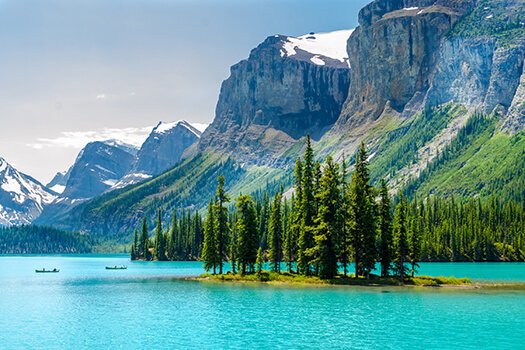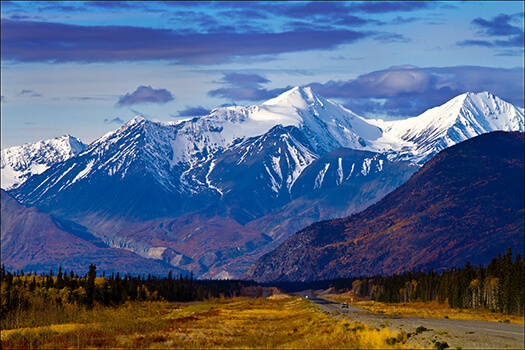Alaska, often referred to as the Last Frontier, is a land of staggering natural beauty and grandeur that beckons travelers from all corners of the globe. This vast state, the largest in the United States, is renowned for its dramatic landscapes, which include towering mountains, expansive forests, and an abundance of wildlife, making it a premier destination for those seeking adventure, tranquility, and a deep connection with nature.
Alaska shares its eastern border with Yukon Territory and British Columbia. To the east, the vast and rugged Yukon Territory presents a landscape as wild and untamed as Alaska itself, offering a continuity of the expansive wilderness and adventurous spirit. Further south, Alaska's border meets British Columbia, a province known for its stunning coastal rainforests, towering mountains, and vibrant wildlife, echoing the natural splendor found in Alaska's own diverse environments. These neighboring regions in Canada complement Alaska's wild and natural beauty, creating a larger tapestry of North American wilderness at its most pristine.
Anchorage, Alaska's largest city, serves as a gateway to the many wonders this state has to offer. With a backdrop of the Chugach Mountains, the city provides a unique blend of outdoor activities and cultural experiences. Visitors can explore the Anchorage Museum to delve into the region's history or set out on hiking trails that begin just steps from the city's center. Whether it's fishing in nearby streams or watching for moose and bears, Anchorage offers a slice of Alaskan wilderness alongside urban amenities.
Further south, the city of Juneau, Alaska's capital, presents its own unique charm. Inaccessible by road, Juneau is a testament to Alaska's wild heart, surrounded by water and ice-capped mountains. Here, tourists can embark on glacier tours, savor fresh seafood, or hike the trails that thread through the lush Tongass National Forest.
To the north lies Fairbanks, a city that shines under the aurora borealis' ethereal glow during the winter months. Fairbanks is an ideal spot for those looking to experience Alaska's interior and its distinct seasons, from the endless daylight of summer to the captivating northern lights in winter.
Ketchikan, gateway to the Inside Passage, is a picturesque town that clings to the water's edge. Renowned for its rich collection of totem poles, it's a place where art, culture, and history converge, providing a deep dive into the native heritage of the region. Its proximity to Misty Fjords National Monument allows for easy exploration of some of the state's most breathtaking scenery.
Not to be overlooked, the charming town of Seward is a hub for marine life exploration and gateway to Kenai Fjords National Park. Its idyllic setting provides opportunities for boat tours to witness glaciers calving into the sea and abundant wildlife, from sea otters to whales.
Alaska's natural attractions are as diverse as its cities. The state is a sanctuary for wildlife, with opportunities to observe bears, moose, eagles, and marine life in their natural habitats. Denali National Park, home to North America's highest peak, offers breathtaking landscapes and wildlife viewing that draw visitors from around the world. For marine life enthusiasts, the Kenai Fjords National Park provides a stunning showcase of marine wildlife and glacier views.
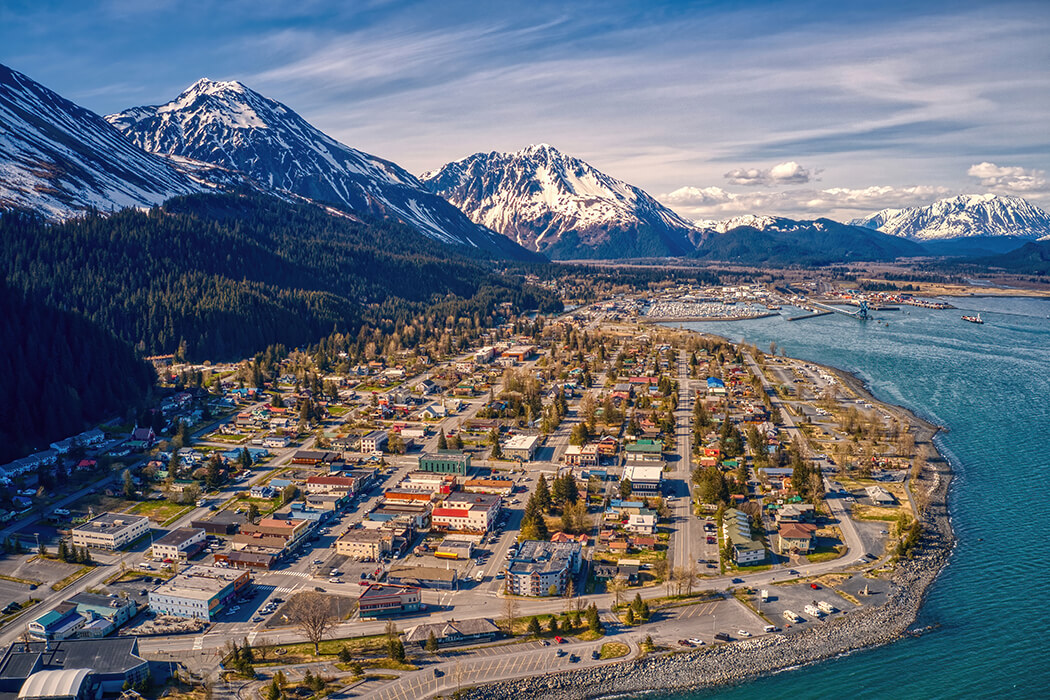
The town of Seward is a prime location for boat tours in Kenai Fjords National Park.
01 | Kenai Fjords National Park
This remarkable park, sprawling over 669,984 acres on the Kenai Peninsula, offers an extraordinary glimpse into the natural world, where glaciers carve the land and wildlife thrives in abundance.
Kenai Fjords is a sanctuary for about 40 glaciers flowing from the Harding Icefield, one of the park's most awe-inspiring features. This icefield is a remnant of the past, a time capsule preserving the icy heart of the Last Frontier. Among these icy giants, Tidewater Glacier stands out for its majestic presence. Towering tall, this glacier offers a spectacular display as it meets the ocean, a phenomenon that encapsulates the park's raw beauty.
Positioned west of Seward, a charming town in Alaska, the park is easily accessible for adventurers and nature enthusiasts. Seward itself is a gateway to the wonders of Kenai Fjords, offering a tranquil yet engaging starting point for exploration. This town, with its scenic views and welcoming atmosphere, serves as a perfect complement to the wilderness just beyond its boundaries.
The wildlife in Kenai Fjords National Park is as diverse as the landscapes. The park's waters are a haven for marine life, including orcas, humpback whales, gray whales, fin whales, and minke whales. Visitors might witness the majestic sight of these creatures, particularly from May through September, when they are most active in these nutrient-rich waters.
Beyond marine life, the park is home to an array of terrestrial animals. Black bears roam the forests and meadows, while mountain goats navigate the steep and rugged terrain with ease. Eagles soar above, their keen eyes scanning the land and sea below. These animals add a dynamic layer to the park's ecosystem, each playing a role in the natural balance of this pristine environment.
Kenai Fjords National Park is not just a destination; it's an experience. It's a place where the grandeur of nature is on full display, from the towering glaciers to the abundant wildlife. Whether you're a seasoned explorer or a curious traveler, the park offers a profound connection to the natural world, inviting you to witness the untamed beauty of Alaska in its purest form.
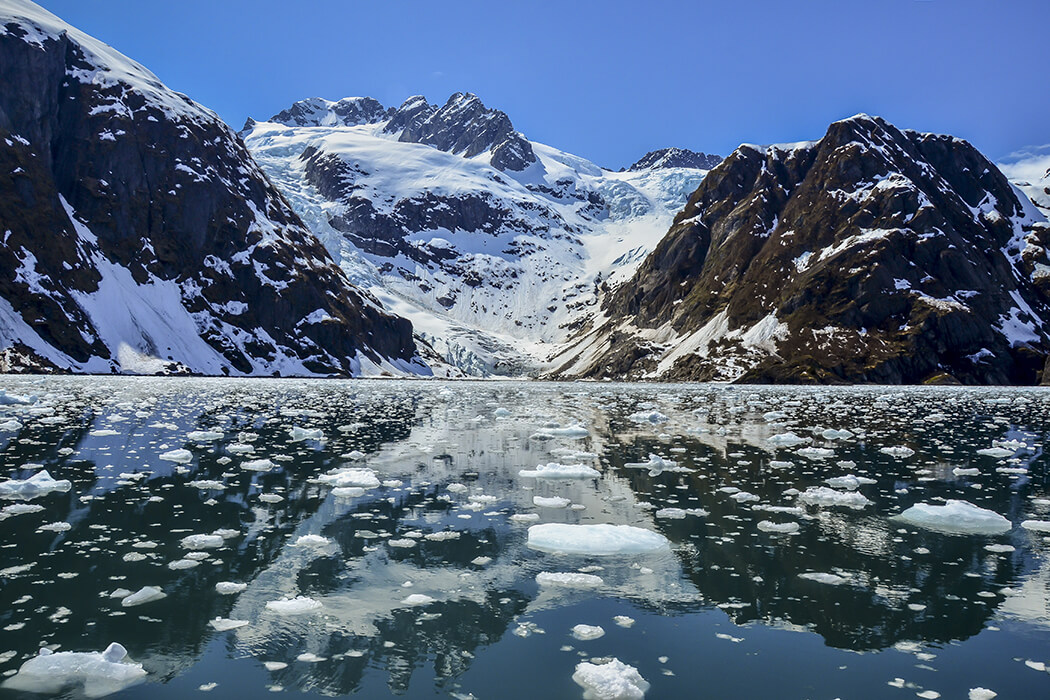
View of Tidewater Glacier in Kenai Fjords National Park.
02 | Denali National Park
In the heart of Alaska, enveloping six million acres of untouched wilderness, lies Denali National Park and Preserve, a realm where nature presents itself on an epic scale. Known for its dramatic landscapes and diverse ecosystems, this national treasure offers an adventure for every kind of explorer. Central to its awe-inspiring geography is Mount McKinley, also known as Denali, which stands as North America's tallest peak. This towering giant, reaching heights of over 20,000 feet, is not just a mountaineer's dream but a symbol of the untamed beauty that defines the park.
The journey into Denali is a profound communion with nature. Visitors often find themselves meandering along the park's solitary road, which provides panoramic views of low valleys and high mountain passes, each unfolding gradually to reveal scenes of tranquil beauty. The park’s design ensures most areas remain wild and undisturbed, offering a sanctuary for wildlife and a playground for adventurers.
Wildlife viewing in Denali is as unpredictable as it is thrilling. The park is home to a remarkable array of animals, including grizzly bears, caribou, moose, wolves, and Dall sheep. These species roam freely across the vast landscapes, from river valleys to alpine tundra, presenting visitors with opportunities for unforgettable encounters. Early mornings or late evenings offer the best chances to witness these creatures in their natural habitats, with the soft light casting the perfect backdrop.
For those inclined to delve deeper into Denali’s wilderness, the park offers a variety of hiking opportunities. From accessible trails like the Horseshoe Lake Trail, which offers serene views of a lake and beaver dams, to the strenuous hike up Mount Healy Overlook Trail, adventurers of all levels find trails that challenge their spirit and reward their efforts with spectacular vistas. The Savage River Loop, a moderate 2-mile trail, is popular among visitors for its stunning river and mountain views, accessible near the park entrance.
Beyond hiking, Denali is a haven for more rugged pursuits. Mountain biking along the park road offers a faster-paced way to enjoy the scenery, while backpacking deep into the heart of the park promises a true backcountry experience for those who carry their life on their backs and their heart on their sleeves. The thrill of mountaineering, particularly the challenge of scaling Denali itself, attracts climbers from around the globe, each eager to test their mettle against the harsh alpine conditions.
For a change of pace, visitors can also engage in ranger-led programs that educate about the park’s ecology, history, and the many species that call it home. These programs provide a deeper understanding of the delicate balance of this ecosystem and the importance of preserving wilderness areas.
Denali National Park and Preserve invites you to immerse yourself in its vastness, to explore its untamed wilderness and leave with stories of majestic peaks, incredible wildlife encounters, and the quiet whispers of nature. Whether on foot, bike, or with a pack on your back, the experiences here are as profound as the landscapes are expansive. The wilderness of Denali does not just surround you; it transforms you.
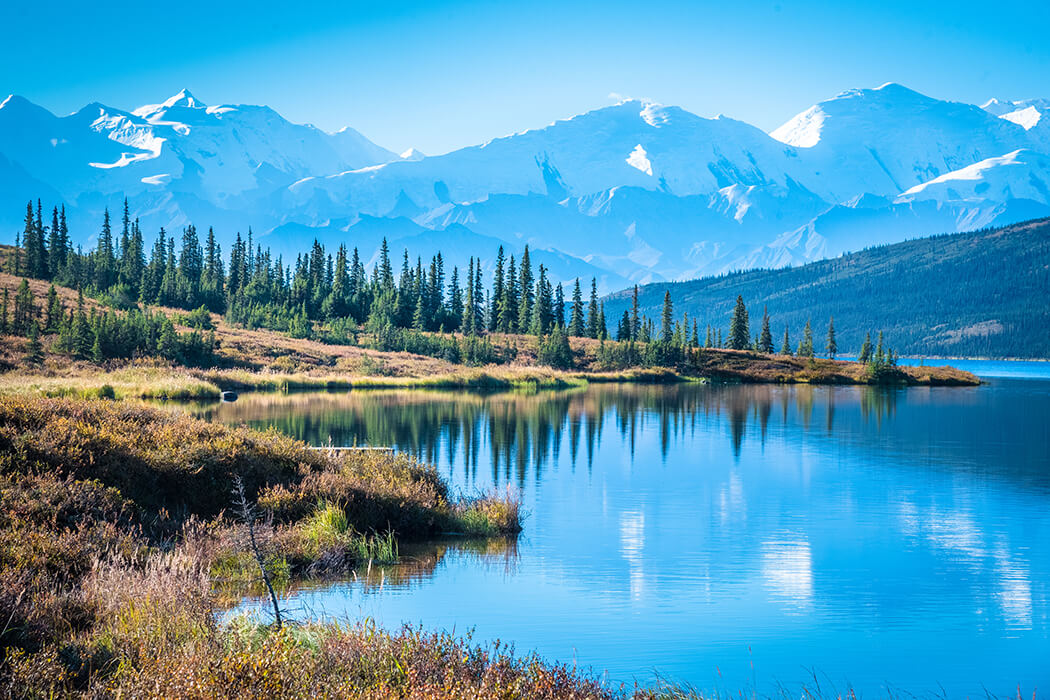
Denali National Park and a stunning view from Wonder Lake.
03 | Tracy Arm
Tracy Arm, a spectacular glacial fjord located just 45 miles south of Juneau, Alaska, offers an unparalleled journey into a natural world preserved in ice and stone. This narrow inlet, embraced by cliffs soaring up to 4,000 feet above the pristine waters, stretches over 30 miles into the heart of Alaska's wilderness. As visitors navigate through this dramatic landscape, they are treated to a mesmerizing display of nature's power and subtlety.
The journey into Tracy Arm is one of contrast and color, where bright blue icebergs float silently alongside the boat, having calved from the twin Sawyer Glaciers at the fjord’s end. These glaciers, active and awe-inspiring, serve as a vivid reminder of the earth's ever-changing nature. The icebergs, some as large as buildings, glisten under the sun, creating a dynamic landscape that captivates photographers and nature enthusiasts alike.
The fjord’s water is often mirror-like, reflecting the towering cliffs and the lush greenery that clings to their steep faces. Waterfalls cascade down these cliffs, fed by melting snow and ice, and add to the auditory experience of this tranquil place. The sound of water striking water mingles with the distant rumble of ice breaking away from the glacier, creating a natural symphony that enhances the visual splendor of Tracy Arm.
Wildlife thrives here, where the harshness of the landscape is belied by the presence of various species that have adapted to this chilly environment. Visitors might catch sight of seals lounging on small ice floes, or watch as bald eagles soar overhead, their keen eyes searching for fish. The lucky few might even spot a bear at the water's edge or a pod of orcas navigating the fjord's icy waters.
The best times to visit Tracy Arm are from May through September, when the weather conditions allow for safer navigation and clearer paths through the ice. During these months, the longer daylight hours illuminate the fjord's features, allowing for full appreciation of its grandeur. Boat tours are a popular way to explore Tracy Arm, as they offer close encounters with the fjord's many wonders while providing the safety and comfort of experienced guides who know these waters well.
Each excursion into Tracy Arm promises a unique adventure, as the landscape continually reshapes itself. The experience of cruising through this remote Alaskan fjord leaves visitors with a profound sense of wonder at the scale and beauty of the natural world. Tracy Arm, with its dramatic ice formations, soaring cliffs, and vibrant ecosystem, stands as one of Alaska's most breathtaking natural attractions, offering a serene yet invigorating escape into the wild.
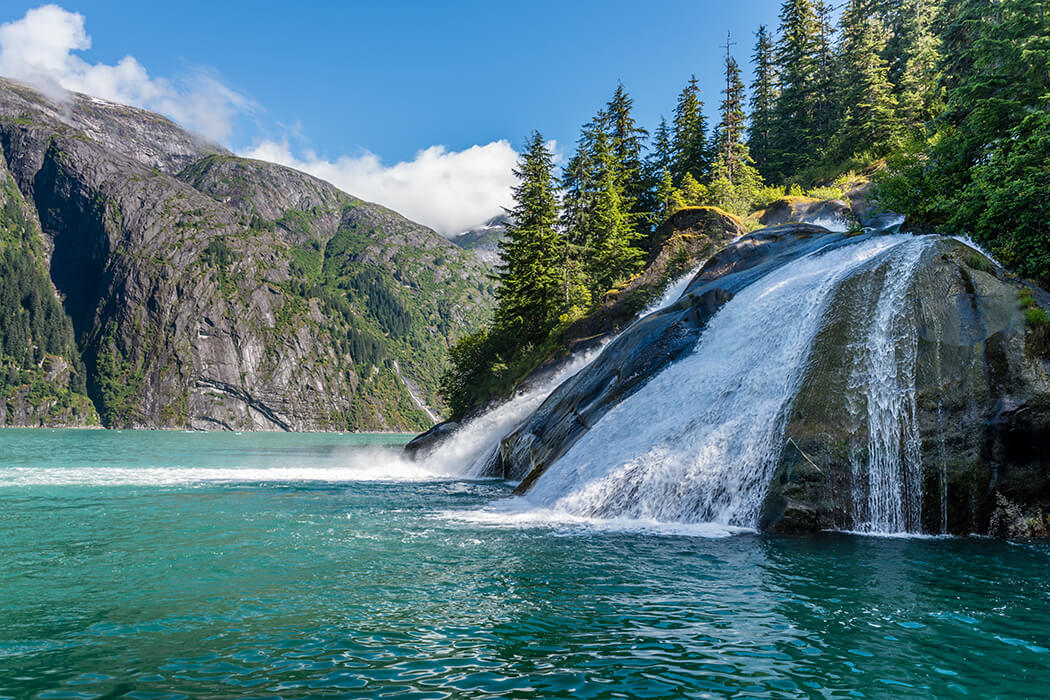
A view of a waterfall pouring water into the sea at Tracy Arm Fjord.
04 | Alaska Wildlife Conservation Center
The Alaska Wildlife Conservation Center (AWCC) offers a unique blend of nature's majesty and dedicated wildlife stewardship on approximately 200 acres of expansive terrain. As a nonprofit organization, the AWCC commits itself wholeheartedly to the conservation of Alaska's wildlife through research, education, and meticulous animal care. This sanctuary not only provides refuge for animals but also serves as an educational platform for visitors to learn about wildlife preservation in one of the world's most captivating natural environments.
Upon visiting the Alaska Wildlife Conservation Center, guests are greeted by a serene landscape where the rugged beauty of Alaska serves as a backdrop for an extraordinary encounter with native wildlife. The center is home to a variety of animals, many of which have been rescued or rehabilitated after injuries. These residents include majestic moose, nimble foxes, and imposing bison, which roam the large enclosures that mimic their natural habitats.
One of the most compelling attractions at the AWCC is the chance to observe brown and black bears. These powerful creatures can be seen exploring their surroundings, offering an up-close perspective that is rare and enlightening. The center also houses a family of playful wolves, whose social interactions and behaviors provide invaluable insights into the dynamics of wild packs.
Visitors might also be delighted by the sight of a bald eagle perched majestically within its designated area, symbolizing the spirit of freedom and resilience. Furthermore, the AWCC is known for its herd of wood bison, a species that the center has been instrumental in reintroducing to the Alaskan wilderness. Seeing these animals in a setting that prioritizes their well-being and conservation is a poignant reminder of the fragility of wildlife populations and the importance of conservation efforts.
The Alaska Wildlife Conservation Center also excels in its educational initiatives. Through guided tours, informative plaques, and interactive sessions, visitors gain a deeper understanding of the challenges facing Alaska's wildlife and the efforts being made to overcome these challenges. These educational programs are tailored to all ages, making the AWCC a valuable visit for families, school groups, and wildlife enthusiasts.
Throughout the year, the center offers different ways to engage with and learn about the animals. Whether it’s witnessing the active behaviors of bears in the summer months or observing the quiet beauty of the center blanketed in snow during winter, each season offers a new way to experience and appreciate Alaska’s wildlife.
A visit to the Alaska Wildlife Conservation Center is more than just a day trip; it's an immersive experience that educates, inspires, and reminds us of our responsibility to the natural world. Here, amid the breathtaking landscapes of Alaska, visitors leave with a renewed appreciation for wildlife and a stronger commitment to its preservation. This sanctuary not only safeguards animals but also ignites a passion for conservation that visitors carry with them long after they leave.
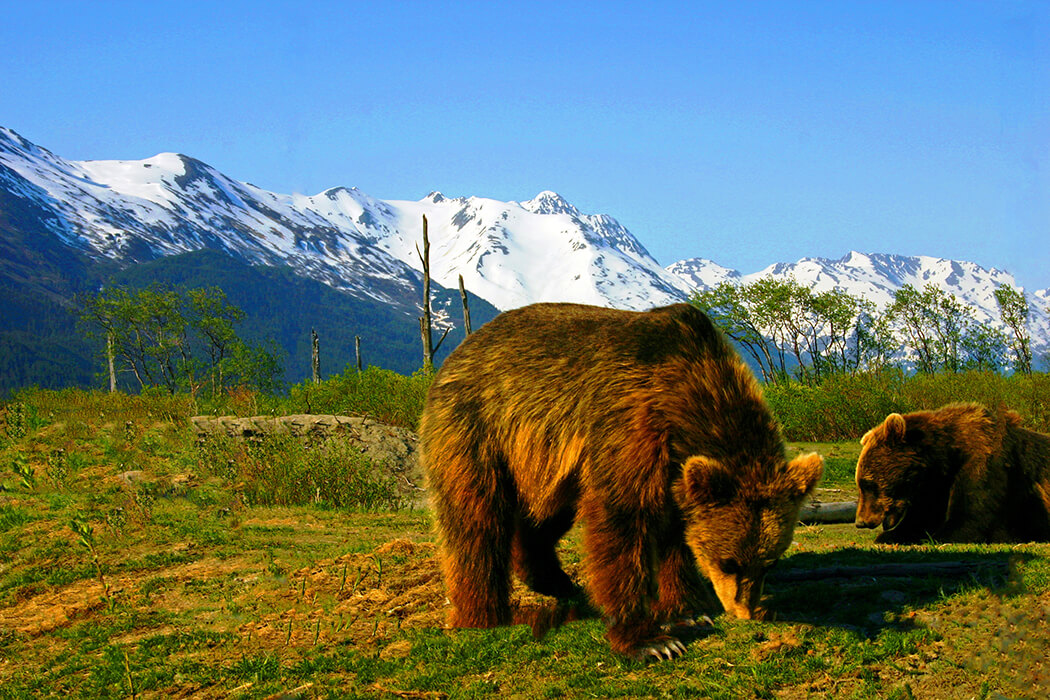
Alaska Wildlife Conservation Center near Portage and Chugach Mountains.
05 | Mendenhall Glacier
Located just 12 miles from Juneau, Mendenhall Glacier stands as one of Alaska’s most accessible and awe-inspiring natural wonders. This magnificent river of ice, spanning 13 miles and descending 4,500 feet from its origins in the vast Juneau Icefield, offers a profound glimpse into the ancient forces of nature that shape our world. The glacier is not only a stunning spectacle but also a compelling study of glacial dynamics and climate change, easily reachable by road, making it an ideal destination for those looking to experience Alaska’s icy wilderness up close.
Visitors to Mendenhall Glacier are treated to a variety of breathtaking vistas and experiences. As you approach the glacier, the landscape transforms; rugged mountains give way to the expansive Mendenhall Lake, formed by the glacier's melting ice, which serves as a dramatic foreground to the icy behemoth. The glacier itself, with its brilliant blue hues and immense scale, is a sight to behold, displaying the raw power and beauty of nature.
The lake, aside from being a picturesque setting for viewing the glacier, offers additional attractions for visitors. Kayaking and canoeing on Mendenhall Lake provide an intimate experience with the landscape, allowing adventurers to glide across the icy waters, navigating between floating icebergs of all shapes and sizes. These activities offer a serene yet exhilarating way to appreciate the grandeur of the glacier from a unique perspective. For those who prefer to stay on land, the area around the lake features several trails ranging from easy walks to more challenging hikes. The Photo Point Trail and Nugget Falls Trail are particularly popular, as they offer spectacular views of the glacier and the thundering Nugget Falls, which cascades nearby.
The glacier is also home to the Mendenhall Glacier Visitor Center, an invaluable resource for understanding the natural history and science behind the glacier. The center provides interactive exhibits and educational programs that delve into the glacier’s ecology, geology, and the broader environmental issues affecting glaciers globally. Rangers at the center are on hand to enhance visitor understanding, offering insights into how the glacier has changed over time and what those changes mean for the region.
Traveling to Mendenhall Glacier, visitors can expect to witness not only the majesty of the glacier itself but also a diverse array of wildlife. The area around the glacier and its lake is home to a variety of animals, including black bears, beavers, and a wide array of bird species. Wildlife watching here, amidst the quiet and the cold, is an experience that underscores the delicate balance of this unique ecosystem.
Visiting Mendenhall Glacier is more than just a sightseeing trip; it is an immersive encounter with one of nature’s most sublime creations. Accessible, educational, and deeply moving, the glacier offers a powerful reminder of the natural world’s splendor and its susceptibility to change. Whether viewed from a kayak, a trail, or the visitor center, Mendenhall Glacier remains one of Alaska’s most compelling destinations, offering memories that last a lifetime.
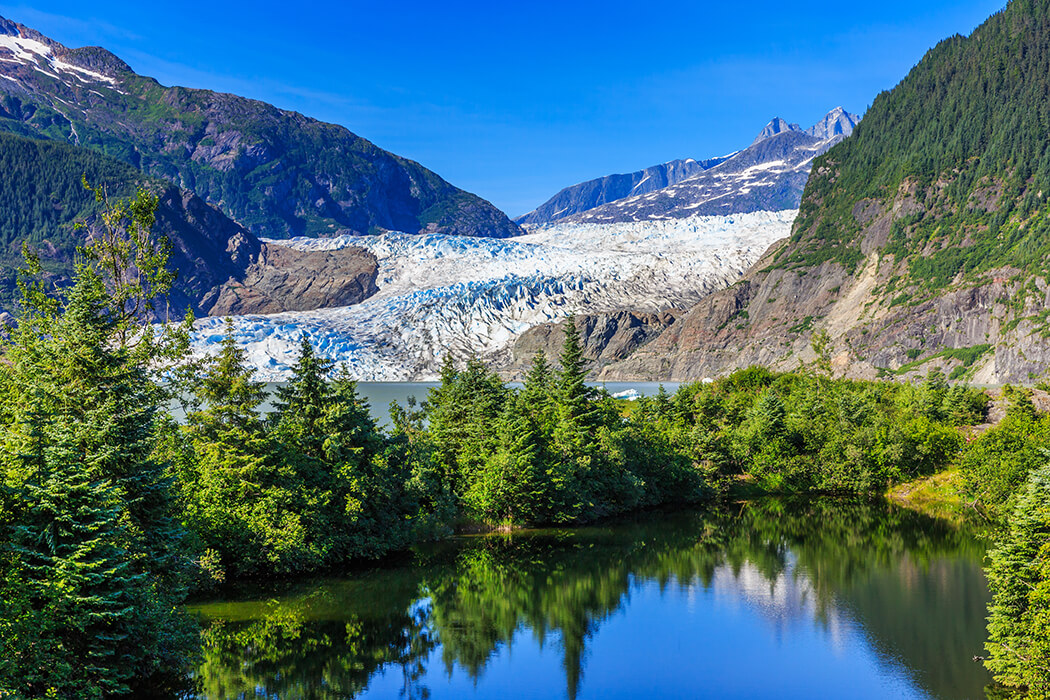
A view of Mendenhall Glacier and lake in Juneau.
06 | Tongass National Park
Tongass National Forest, stretching across an astonishing 16.7 million acres, holds the title of the largest national forest in the United States. This vast expanse of land, located in southeastern Alaska, encompasses a breathtaking array of landscapes, from dense rainforests and towering mountains to deep fjords and ice fields. This remarkable diversity not only provides stunning scenery but also supports a rich variety of wildlife, making Tongass a destination like no other.
Visitors to Tongass National Forest are welcomed into a world where nature reigns supreme. The forest is a sanctuary for many species of wildlife, particularly noted for its populations of both black and brown bears. These majestic creatures roam the dense undergrowth of the forest and frequent the streams and rivers, especially during the salmon spawning season, offering a spectacular view of nature's cycle in action. Observing these bears in their natural habitat, one gains a profound respect for the power and the delicate balance of Alaska's ecosystems.
The forest is also home to a host of other wildlife, including Sitka black-tailed deer, bald eagles, and numerous species of marine life. The bald eagle, with its impressive wingspan and keen eyesight, is a common sight here, often seen perched atop tall tree stands or soaring over the waterways. The presence of such diverse wildlife provides endless opportunities for wildlife enthusiasts and photographers aiming to capture the essence of Alaska's wild beauty.
Tongass National Forest is not only about its wildlife. The park features some of the most iconic and picturesque landscapes in Alaska, including the Misty Fjords National Monument Wilderness and Tracy Arm fjord. Misty Fjords, with its dramatic cliffs and waterfalls cascading into deep, narrow fjords, offers a surreal landscape often shrouded in ethereal fog, giving it a mystical quality that enchants visitors. Boat tours and floatplanes are popular ways to explore this remote wilderness, providing awe-inspiring views of its serene waters and craggy rock faces.
Similarly, Tracy Arm fjord offers a landscape dominated by towering glaciers and floating icebergs. The sheer scale of the glaciers, coupled with the pristine waters and the dramatic cliffs that border the fjord, creates a natural spectacle that is both humbling and exhilarating. This area is accessible by boat, allowing visitors to navigate close to the glacier faces where the sounds of calving ice echo through the air, creating a dynamic and unforgettable natural experience.
Visiting Tongass National Forest is an adventure that engages all the senses. It's a place where the air is fresh, the landscapes are seemingly endless, and the sights and sounds of wildlife fill the vast wilderness. It's a destination for those who seek to reconnect with nature and experience the untouched beauty of one of America's last great wild places. Whether you are a hiker, a wildlife observer, or simply someone who appreciates the grandeur of natural landscapes, Tongass National Forest offers an escape into a world where nature's impressive scale and beauty are on full display.
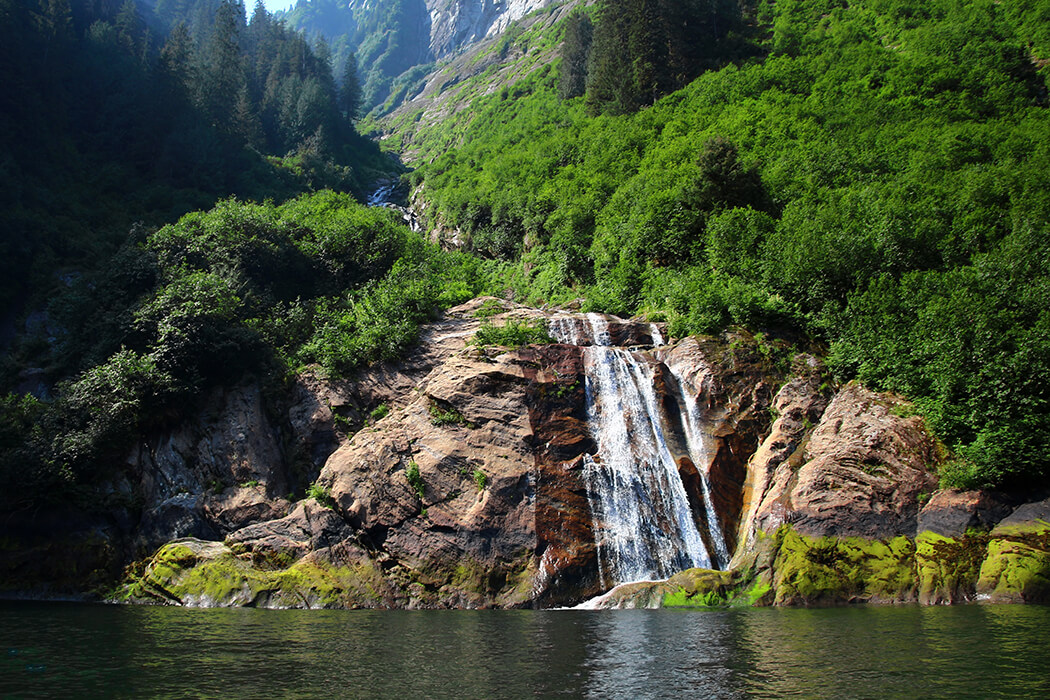
Tongass National Forest in Misty Fjords National Monument.
07 | Hubbard Glacier
Located within the vast expanses of Wrangell-St. Elias National Park and Preserve, Hubbard Glacier stands as one of Alaska's most dynamic and awe-inspiring natural wonders. Known affectionately as 'the Galloping Glacier,' this colossal ice mass is renowned not only for its impressive size but also for its unusually rapid advance into the sea, which starkly contrasts with the retreat observed in many of the world's other glaciers.
The term "galloping" aptly describes Hubbard Glacier's behavior, as it surges forward at a noticeable pace, sometimes advancing as much as several feet per day. This rapid movement results in spectacular displays of calving, where large chunks of ice break off from the glacier and crash into the waters of Disenchantment Bay. The sound of ice breaking, often referred to as "white thunder," echoes dramatically through the air, creating a powerful reminder of nature's force and the ever-changing landscape of the Arctic region.
Visitors to Hubbard Glacier are treated to more than just the thunderous spectacle of calving ice. The glacier itself, with its towering face and deep blue crevasses, presents a breathtaking view against the rugged backdrop of Alaska's mountains. The surrounding area, part of the larger Wrangell-St. Elias National Park, is an ecological haven, rich in wildlife and diverse plant species. The park itself is a paradise for nature enthusiasts and offers numerous opportunities for photography, wildlife viewing, and simply soaking in the vast, untouched wilderness.
The approach to Hubbard Glacier is an experience in itself. As visitors near the glacier by boat, they often witness icebergs floating in the chilly waters, each uniquely shaped by the forces that have carved them away from the glacier. These icebergs serve as floating habitats for various marine birds and sometimes seals, who can be seen sunbathing on the ice. The water's icy blue color, a result of the glacial silt, contrasts beautifully with the stark white of the ice and the dark greens and browns of the distant shoreline.
Traveling to Hubbard Glacier provides a unique opportunity to witness one of nature's most impressive processes. The best times to visit are during the late spring and summer months, when the weather is milder and the daylight extends for most of the day, allowing for extended viewing times and safer navigation in the icy waters.
A visit to Hubbard Glacier is not just a journey into a remote part of Alaska but also a profound encounter with the natural world's raw power and beauty. It's a place where the silence of the wilderness is broken by the crack of calving ice, where visitors gain a new appreciation for the planet's grandeur and the delicate ecological balances that sustain it. This glacier, ever-moving and awe-inspiring, offers an unforgettable experience that stays with you long after you've returned from its icy realm.
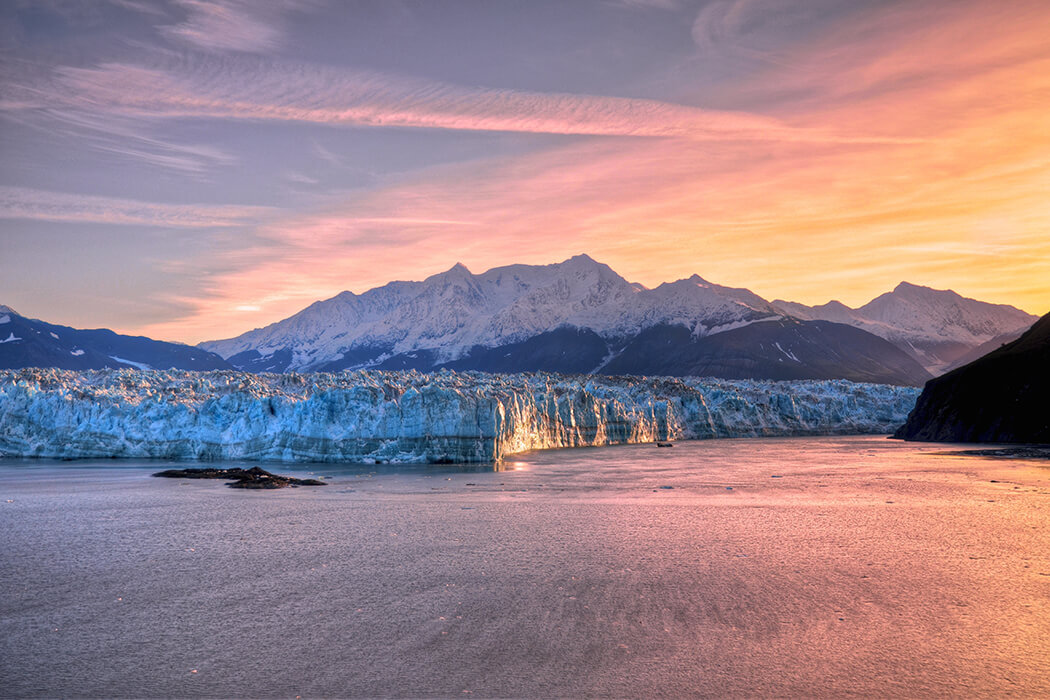
Hubbard Glacier at sunrise.
08 | Glacier Bay National Park and Preserve
In the remote stretches of southeastern Alaska, Glacier Bay National Park and Preserve offers a breathtaking experience of nature's power and tranquility. This vast park, known for its rugged landscapes and dynamic glaciers, presents a spectacle of nature that draws visitors from around the globe. The allure of the park is its dramatic glacial scenery, diverse wildlife, and opportunities for adventure in one of the planet's most pristine environments.
As visitors enter Glacier Bay, they are immediately struck by the sheer scale of its natural beauty. The park is home to a stunning array of tidewater glaciers, some of which actively calve huge blocks of ice into the bay, creating a dynamic landscape that is constantly being reshaped. This phenomenon not only provides a thrilling spectacle but also allows for an up-close look at the processes that have shaped the Earth's surface for millions of years.
The best times to visit Glacier Bay National Park and Preserve are from late spring through early fall. During these months, the weather is generally more conducive to exploring the outdoors, with longer daylight hours that illuminate the dramatic landscapes. This period also offers the best opportunities for wildlife viewing and engaging in various recreational activities such as kayaking, hiking, and scenic cruises.
Wildlife enthusiasts will find Glacier Bay particularly enchanting. The park is a haven for many species adapted to its cold, rugged environment. Visitors might spot brown and black bears roaming the shores, while moose are occasionally seen in the more vegetated areas. The waters of the bay are rich with marine life, including humpback whales, sea otters, seals, and porpoises, often visible from the deck of a boat or the shorelines. Birdwatchers can delight in observing bald eagles, puffins, and a variety of other seabirds that make their home in the coastal and forested areas of the park.
For those looking to extend their stay within this stunning natural setting, Glacier Bay Lodge offers a comfortable and scenic accommodation option. The lodge, the only formal accommodation within the park, provides guests with a cozy retreat that complements the park’s natural beauty. From the lodge, visitors have easy access to a range of activities and guided tours, making it a perfect base for exploring the surrounding wilderness. The lodge's large windows and open decks allow guests to continue enjoying the panoramic views of the bay and its glaciers, even when indoors.
Glacier Bay Lodge also serves as a starting point for many of the park’s ranger-led programs, which educate visitors about the area's natural history, glaciers, and ecosystems. These programs are an excellent way to gain deeper insights into the environmental significance and the delicate ecological balance of Glacier Bay.
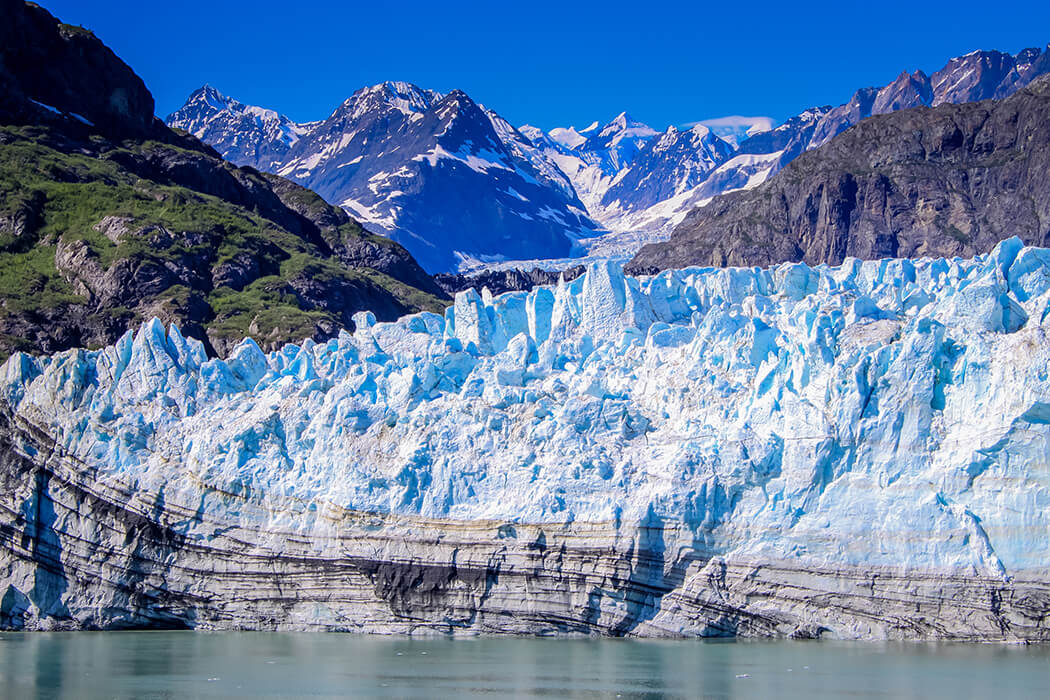
View of the edge of a glacier at Alaska Glacier Bay National Park and Preserve.
Share article:


